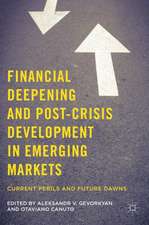Understanding Consumer Financial Behavior: Money Management in an Age of Financial Illiteracy
Autor W. Fred van Raaijen Limba Engleză Hardback – 22 feb 2016
Government policies, marketing campaigns of banks, insurance companies, and other financial institutions, and consumers' protective actions all depend on assumptions about consumer financial behavior. Unfortunately, many consumers have no or little knowledge of budgeting, financial products, and financial planning. It is therefore important that organizations and market authorities know why consumers spend, borrow, insure, invest, and save for their retirement - or why they do not. Understanding Consumer Financial Behavior provides a systemic economic and behavioral approach to the way people handle their finances. It discusses the different types of financial behaviors consumers may engage in and explores the psychological explanations for their behavior and choices. This exciting new book is essential reading for scholars of marketing, finance, and management; financial professionals; and consumer policy makers.
| Toate formatele și edițiile | Preț | Express |
|---|---|---|
| Paperback (1) | 777.03 lei 43-57 zile | |
| Palgrave Macmillan US – 28 iun 2016 | 777.03 lei 43-57 zile | |
| Hardback (1) | 880.11 lei 43-57 zile | |
| Palgrave Macmillan US – 22 feb 2016 | 880.11 lei 43-57 zile |
Preț: 880.11 lei
Preț vechi: 1073.31 lei
-18% Nou
Puncte Express: 1320
Preț estimativ în valută:
168.41€ • 176.28$ • 140.17£
168.41€ • 176.28$ • 140.17£
Carte tipărită la comandă
Livrare economică 31 martie-14 aprilie
Preluare comenzi: 021 569.72.76
Specificații
ISBN-13: 9781137544247
ISBN-10: 1137544244
Pagini: 285
Ilustrații: XVI, 285 p.
Dimensiuni: 140 x 216 x 18 mm
Greutate: 4.83 kg
Ediția:1st ed. 2016
Editura: Palgrave Macmillan US
Colecția Palgrave Macmillan
Locul publicării:New York, United States
ISBN-10: 1137544244
Pagini: 285
Ilustrații: XVI, 285 p.
Dimensiuni: 140 x 216 x 18 mm
Greutate: 4.83 kg
Ediția:1st ed. 2016
Editura: Palgrave Macmillan US
Colecția Palgrave Macmillan
Locul publicării:New York, United States
Cuprins
1. Introduction
PART I
2. Money Management
3. Saving Behavior
4. Credit Behavior and Debt Problems
5. Insurance and Prevention Behavior
6. Pension Plans and Retirement Plans
7. Investment Behavior
8. Tax Behavior: Compliance and Evasion
9. Victims of Financial Fraud
10. Responsible Financial Behavior
PART II
11. Individual Differences and Segmentation
12. Confidence and Trust
13. Loss Aversion and Reference Points
14. Risk Preference
15. Time Preference
16. Decision Making, Decision Architecture, and Defaults
17. Self-Regulation
PART I
2. Money Management
3. Saving Behavior
4. Credit Behavior and Debt Problems
5. Insurance and Prevention Behavior
6. Pension Plans and Retirement Plans
7. Investment Behavior
8. Tax Behavior: Compliance and Evasion
9. Victims of Financial Fraud
10. Responsible Financial Behavior
PART II
11. Individual Differences and Segmentation
12. Confidence and Trust
13. Loss Aversion and Reference Points
14. Risk Preference
15. Time Preference
16. Decision Making, Decision Architecture, and Defaults
17. Self-Regulation
Recenzii
“W. Fred van Raaij seeks to describe the foundations of our financial actions and, in turn, provide direction toward improved public policies, better regulation for consumer protection, and more trustworthy financial practices. … For psychologists, the book offers a handy guide to how economists think about the determinants of financial behaviors … . I also see van Raaij’s book as a supplemental text for graduate courses in finance and as highly recommended reading for professional financial advisers.” (Len Tashman, PsycCRITIQUES, Vol. 61 (46), November, 2016)
Notă biografică
W. Fred van Raaij is Emeritus Professor of Economic Psychology at Tilburg University, the Netherlands. He has worked at Tilburg University and Erasmus University of Rotterdam in the Netherlands, and at the University of Illinois at Urbana-Champaign, USA. His research interests are consumer behavior, environmental concerns and energy saving, the financial behavior of consumers and investors, and the effects of marketing communications.
Textul de pe ultima copertă
Government policies, marketing campaigns of banks, insurance companies, and other financial institutions, and consumers' protective actions all depend on assumptions about consumer financial behavior. Unfortunately, many consumers have no or little knowledge of budgeting, financial products, and financial planning. It is therefore important that organizations and market authorities know why consumers spend, borrow, insure, invest, and save for their retirement - or why they do not. Understanding Consumer Financial Behavior provides a systemic economic and behavioral approach to the way people handle their finances. It discusses the different types of financial behaviors consumers may engage in and explores the psychological explanations for their behavior and choices. This exciting new book is essential reading for scholars of marketing, finance, and management; financial professionals; and consumer policy makers.







